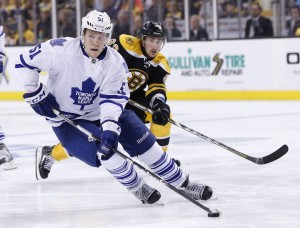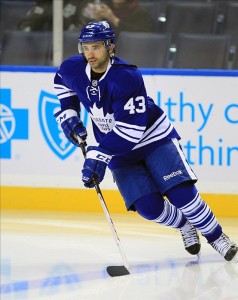It’s almost New Years and the NHL is about to resume play after a three-day Christmas break, which makes this the perfect time to look beyond the win/loss record and see what might be in store for the Leafs for the rest of the season.
Standings
The Leafs have a record of 20-12-3 which is good enough for fourth in the division and seventh in the Playoff Race. They currently sit four points ahead of Boston and five ahead of Florida in the Wild Card race.
One positive that cannot be overlooked is that they have 18 regulation wins, which is tied for fourth in the Conference, or second most, depending on how you choose to view it. They also lead the NHL with 118 goals for. Unfortunately, their 102 goals against is the worst in the NHL among teams currently sitting in a playoff spot.
Corsi
For those who are not sure what Corsi is, or why it’s so important, here is a great link explaining everything. In case you don’t want to get too much into it, basically it’s just an attempt to track possession of the puck by using shot attempts as a proxy. A team or player’s Corsi rating is just the total number of shots attempted minus the shots attempted by the other team. This correlates heavily with winning games, since, over a great enough amount of time, the quality of shots is averaged out and teams possessing the puck more tend to win more games.
So far this year, the Leafs have attempted to shoot the puck 1405 times, but their opponents have put 1688 shot attempts towards the Leaf’s goal, resulting in a Corsi For % of 45.4. This ranks them 27th in the NHL and is highly suggestive of their current record being much better than they deserve. It does, however, suggest that Jonathan Bernier might get into the Hart Trophy conversation if this keeps up and the team actually does finish high in the standings.

PDO
Here is a brief explanation of PDO from Cam Charron, a writer hired by the Leafs this past summer:
“PDO, at a team-level, is the simple addition of shooting percentage and save percentage at even strength. If a team’s save percentage is .927 and they’re shooting at 8.0%, their “PDO” could be counted as 1007, 100.7% or 1.007. If a team’s save percentage is .900 and they’re shooting at 9.4%, their “PDO” would be recorded as 994, 99.4%, or 0.994.”
Shooting percentage + Save Percentage = PDO and this number is said to revert to 100 over time, meaning that teams that have a PDO over 100 are getting lucky by having an unsustainably high shooting or save percentage.
The Leafs currently sit third in the NHL with a PDO of 101.7. This is not good news for anyone hoping the team continues to have such favorable results in the win column. Here’s a link to the Charron column, if you’re interested.
Special Teams
The Leafs currently rank 9th in the NHL with a PP operating at a 20.3% efficiency. They also have had the 3rd most PP attempts in the NHL and are last in the NHL with 5 short-handed goals allowed.
On the PK the Leafs are 10th with an 83.9% kill-rate. They have also lead the NHL in short-handed goals with 6.
To be in the top 1/3rd of the league in both special teams and only be four points up on the team chasing them for the playoffs does not bode well for their game at even-strength. It is nice the special teams are clicking, but it doesn’t bode well for the team going forward that they rely so heavily on special teams and goaltending to win games.

Individual Players
Phil Kessel continues to be one of the NHL’s best players. He has 17 goals (5th) and 38 points (6th).
JVR has 15 goals (T-7th) and 32 points (T-10th).
While it is great to have two players so high in the individual standings, the Leafs are faced with the problem that the line they employ as their #1 unit is absolutely dominated in terms of puck possession on a daily basis. The line of JVR, Kessel and Bozak has a CF% in the mid-to low 40s and this means that they can only be effective if the Leafs goalie has a great game.
Jonathan Bernier sits in the middle of the NHL with 14 wins, but his save % of .921% is outstanding when you consider that the Leafs are out-shot on a regular basis and are demonstrably one of the worst defensive teams in the NHL. Of goalies who have played at least 20 games, Bernier is 8th in S% and only Carey Price and Craig Anderson play for comparably bad teams, in terms of defense. You could make a decent argument that he should at least be in the Vezina conversation at this point, if not the outright winner.

How to Improve
The Leafs, it seems, are a team that must get stellar goaltending to be competitive, but perhaps a few roster tweaks could drastically change this, even if they are only internal. The only bad thing they could do is continue on doing what they’ve done all year, because there is a very, very strong chance that if they keep the same coach and do the same things, they’ll miss the Playoffs yet again.
At this point, I think it’s fair to say that Randy Carlyle is what he is: a coach who’s teams are constantly poor possession teams. Since I could coach an NHL team to a cup victory if I got good enough goaltending, I think it’s clear the Leafs have to make a change. The team signaled a new direction in the summer by hiring Dubas and Hunter, and it’s time to make good on that promise.
The only Leafs forward who breaks even consistently from a puck-possession standpoint is Nazem Kadri. His points totals are reflective of his ice time, but he now has a body of work that suggests he’s the Leafs all-round best forward and he should be employed as the teams top centre from now on and he should get the most ice time on the team, be it at regular strength or on the PP. Kadri and Kessel should be joined at the hip and never see the ice unless their both on it. Until a second line centre can be acquired, Holland and JVR should be centred by Bozak on the second line.
On Defense, the picture is also stark. Phaneuf and Frason form the top pair, but they have only a 46.9% CF when they are paired together. On the other hand, when paired with Morgan Rielly – even though the sample size is extremely small – Phaneuf and Reilly have a positive possession number.
Also, While Jake Gardiner has struggled, apparently, even a cursory look into his advanced stats suggests that he has been employed horribly. Gardiner has a PDO of 97.5, suggesting he has been very unlucky so far this season. When paired with Franson he has a 58% Corsi-For rating, even though it is a small sample size. Still, for the last three years, whenever they have been paired together, they are an effective duo and should be re-united immediately.
Furthermore, Gardiner’s most common partners this year are Polak and Holzer – two players who are extremely poor possession players. It seems that Gardiner’s struggles may have more to do with having bad partners than his own play. Yes, he is risky, but those are high-impact/ low-occurrence risks that he is being blamed for, meaning they are remembered more than they deserve to be and impact the game less than most people tend to think. Even if he makes a few errors per game, it is irrelevant if he is a positive possession player, which, if paired with Cody Franson, I have no doubt he would be.
For the Leafs to be successful in the second half, it would be wise to re-unite Franson and Gardiner on the top pairing and Phaneuf and Reilly on the second pairing. Limiting the ice time of Holzer,Polak, Robidas and Percy should also be a priority.
All stats from Stats.HockeyAnalysis.com and NHL.com
Thanks for reading.
Maybe Gardiner isn’t having that bad a season and the stats are more reliable than what you think you see when you watch TV. Even Ken Hitchcock said he was blown away by the difference between his eyes and the stats. The fact is, the data suggests Gardiner does well with some players and badly with others and if he isn’t being put in a position to succeed, that’s on the coach. As for shot quality, some shots will be good, some will be bad, but if you play long enough it all averages out. I am not sure how I could cite that; it seems like asking me to cite a source for saying something is green or large or hot or yellow – it just seems obvious.
Two observations. First is the off-handed way you dismiss “Quality of Shots”. Where is your data backing up that claim? Second, is the fact that Gardiner is having a terrible season and is easily their worst dman, but because his advanced numbers are so good, it has to be someone else’s fault, his line mates or the coach. I find it interesting that in today’s NHL when a player plays well it is his doing but when they struggle it is because he is being mishandled by his coach. Gardiner is having a terrible season this season, just as Reimer had a terrible season last season. It is not Carlyle’s fault. It is no ones fault but their own. I am happy to see Reimer has seemed to have worked through it and hopefully Gardiner will too.
do a story on the lives of colton orr and mc laren and what there furure holds nd why are they still being paid